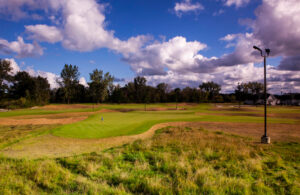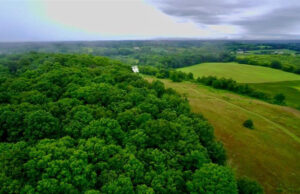New USGA research evaluating plant growth regulators

The USGA continues to support research evaluating plant growth regulators and how they impact new creeping bentgrass cultivars, fertilizer rates, or how they could even help transition from annual bluegrass to bentgrass. Two research projects currently underway, one at Ohio State University and the other at Rutgers University, are summarized in this article.
Ohio State University
At Ohio State University, Ed Nangle, Ph.D., Dominic Petrella, Ph.D., and Florence Sessoms, Ph.D., are conducting a three-year project to evaluate how new creeping cultivars respond to lower nitrogen application rates, both in the presence and absence of various plant growth regulators. This research will help guide turfgrass management practices, especially for golf course superintendents transitioning greens to newer cultivars.
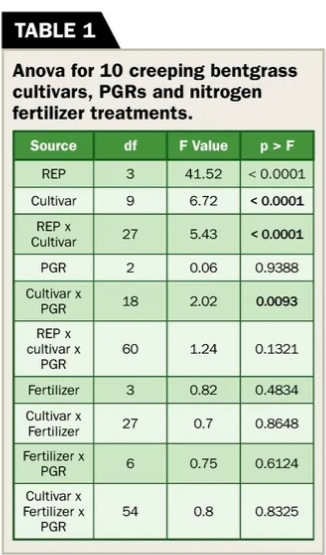
The research monitors organic matter accumulation across 10 cultivars, nitrogen application rates and plant growth regulator treatments. They also determine whether lower nitrogen rates can be effectively used without compromising green quality and playability.
Several new creeping bentgrass cultivars have been released over the last 10 years, with many improvements noted for responses to environmental stresses. New construction or golf course renovations using the new cultivars are not matched with data for the annual inputs that turfgrass managers would use.
Cultural practices and inputs directly affect the playability of the putting green surfaces and their long-term competitiveness. For example, this research has environmental and return-on-investment implications if the new cultivars can produce high-quality playing surfaces at lower nitrogen rates.
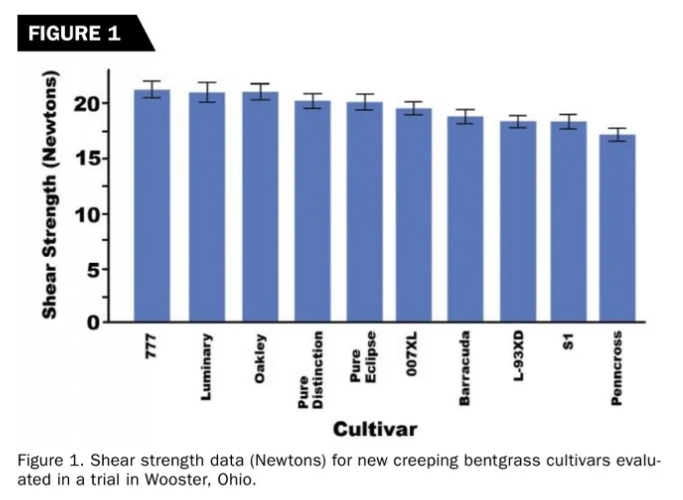
The research green was constructed in the autumn of 2022 on a 10-inch rootzone of 80:20 sand:peat, with the 10 cultivars seeded at that time in a randomized complete block design with four replications. The green is mowed at a height of 0.125 inches daily with clippings collected and irrigated with overhead irrigation.
Urea (46-0-0) was used as the nitrogen source and was applied as a liquid application. Nitrogen rates included 0, 0.5, 1.0, 1.25 and 2.0 pounds N per 1,000 sq. ft. annually and applied biweekly at equal rates across all treatments during the growing season. Initial establishment of plots included using 1.0 pounds P per 1,000 sq. ft. to help with establishment.
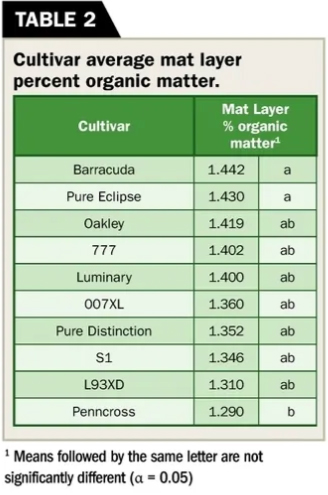
All plots received preventative fungicide and insecticide applications, excluding DMI products due to their growth-regulation effects. Two growth regulators were applied — Anuew (prohexadione calcium) and Trimmit (paclobutrazol) — following recommended label rates at 280 growing degree days (GDD) with a base temperature of 32 degrees F.
Results
The researchers have observed differences in response to the nitrogen rates across multiple parameters and between the cultivars. Penncross clearly needed higher nitrogen rates, as its DGCI values, color ratings (Photo 1) and shear strength values (Figure 1) indicate significantly lower ratings than many of the newer cultivars.
Differences in organic matter accumulation occurred between the cultivars, with Barracuda and Pure Eclipse providing significantly higher organic matter levels than Penncross within 1 1/2 years of the trial initiation (Table 2).
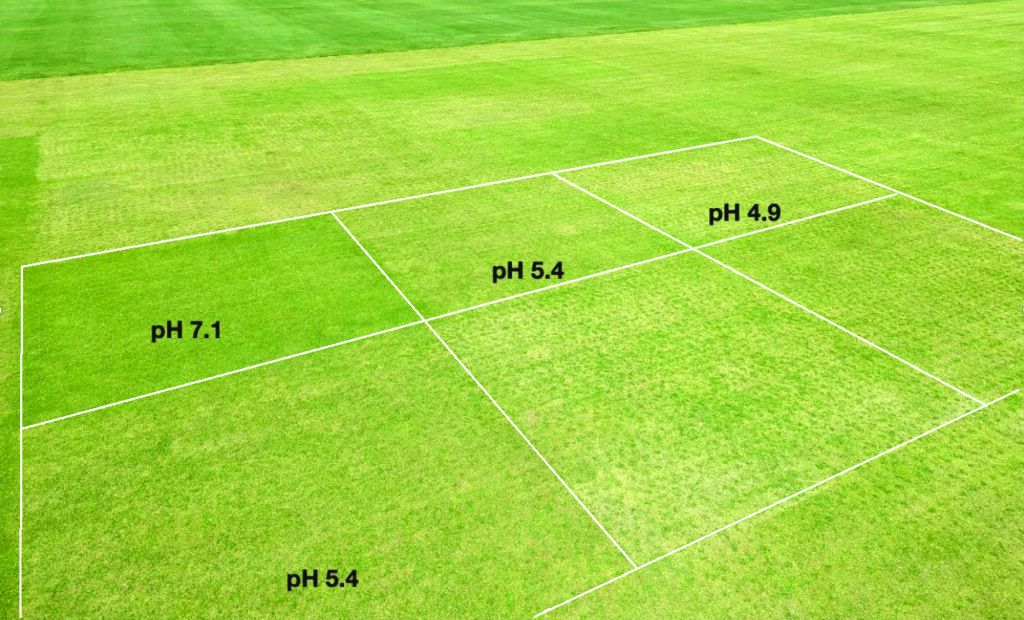
Their early results also show clear differences in green speed for growth regulator plots compared to the untreated plots. Anuew and Trimmit produced green speeds 8 and 12 inches greater than the untreated control (Table 3).
The outlook for the project is to complete further playability data collection in the spring and fall of 2025 with two additional rounds of organic matter analysis. The researchers believe there will be further separation between the cultivars regarding organic matter accumulation.
Slight differences in playability are expected, and cultivar response to Trimmit applications warrants further investigation. The clear difference between Penncross and the new cultivars will require superintendents to adjust nitrogen rates to experience potential environmental and economic benefits.
Rutgers University
At Rutgers University, Matt Elmore, Ph.D., and Jim Murphy, Ph.D., are finishing up with two projects to suppress annual bluegrass growth. Their first objective was to evaluate a combination of cultural (phosphorus and pH) and Trimmit (paclobutrazol) for annual bluegrass suppression in bentgrass putting greens (Project 1). They hypothesize that a strongly acidic rootzone (pH ~5.5) combined with relatively low rootzone phosphorus (6 to 10 ppm) will promote creeping bentgrass encroachment into annual bluegrass.
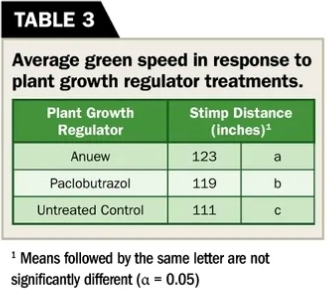
They expanded the research to include an additional field trial to study annual bluegrass and creeping bentgrass putting green population dyanamics using a five-level pH gradient and Penncross vs. Oakley creeping bentgrass (Project 2). The 2024 objective was to adjust the phosphorus and pH levels in the annual bluegrass putting green before creeping bentgrass is seeded and measure its spread in 2025.
The site irrigation was monitored daily during the summer, typically with overhead irrigation to 60 percent of ET and hand-watering where needed to maintain VWC at 20-25 percent. The site for both projects was core-cultivated on Sept. 17, 2024, using half-inch tines on a 2-by-2-inch spacing. The site for Project 1 was core cultivated again on Oct. 17, 2024, using 5/16-inch tines on a 2-by-3-inch spacing to accelerate phosphorus removal.
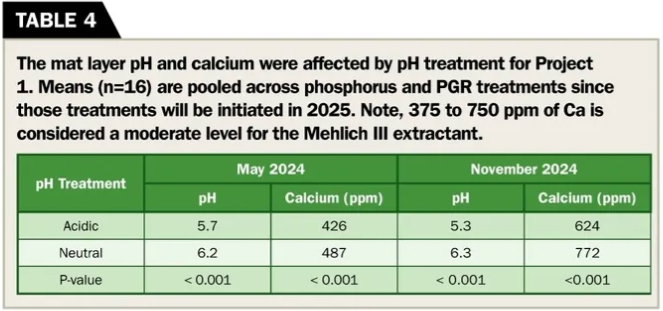
Lime (75 pounds per 1,000 sq. ft.) was applied to the neutral pH plots on June 13 and Nov. 8, 2024, and gypsum (19 pounds per 1,000 sq. ft.) was applied to the acidic pH plots on June 13, Aug. 7 and Nov. 8, 2024 for Project 1. Lime was applied at 1.6, 4.7, 14.0, 42.8 and 128.6 pounds per 1,000 sq. ft. on Nov. 8, 2024, for Project 2. Gypsum was applied to both gypsum treatments at 18.9 pounds per 1,000 sq. ft. on Aug. 29 and Nov. 8, 2024, for Project 2.
The mat layer sampling occurred just before amendment applications in May and November 2024. Six samples per plot were collected with a 0.75-inch diameter probe from each plot, forming one composite sample tested for pH and nutrient (Mehlich III extractant) analysis.
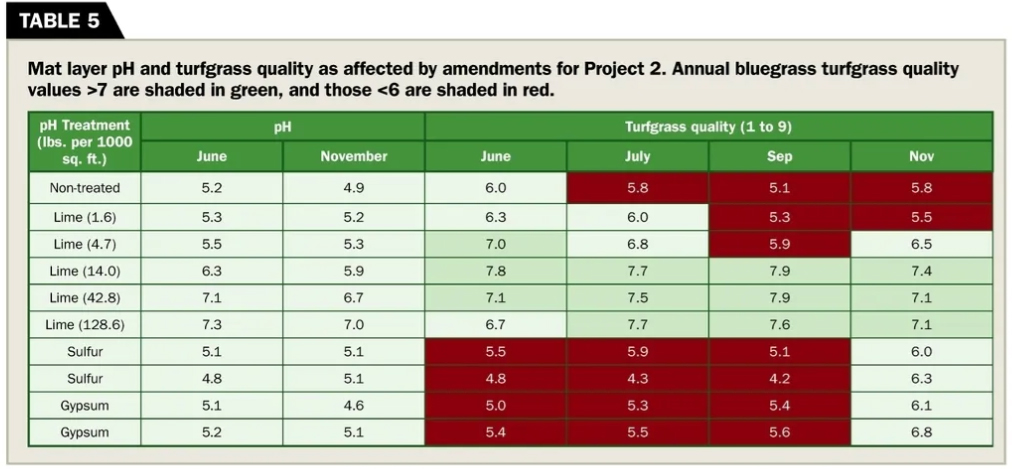
Turfgrass quality was evaluated visually on a 1 (poor) to 9 (excellent) scale. Factors that produce a high-quality playing surface, such as turfgrass density, texture, surface uniformity and smoothness, more so than color, were considered in the quality ranking.
Results
In Project 1, they reported the effect of pH treatment on the mat layer pH was highly significant (P < 0.001) on both sampling dates (Table 4). This finding indicates that exclusively using ammonium sulfate as the N source has the intended effect of acidifying the mat layer pH, and amending the neutral pH plots with lime also has the intended effect. The pH differences produced lower turfgrass quality (P < 0.001) in the acidic plots (6.2) compared to neutral plots (7.3) when evaluated on Sept. 15.
The site was monitored daily during the summer, and differences in turfgrass quality were not caused by drought stress or anthracnose, but due to cumulative effects of poor vigor and summer stress in plots with low mat layer pH. The pH treatment significantly affects the calcium in the mat layer, likely due to the high water solubility of gypsum, which limits calcium retention compared to lime (Table 1). While statistically significant, these calcium differences were expected and are probably not agronomically meaningful since calcium levels were within the moderate range of 375 to 750 ppm.
There were no differences in phosphorus levels among plots on either sampling date (P > 0.2), which is expected as no phosphorus was applied. However, it is concerning that the mean mat layer phosphorus across all the plots increased from 38 ppm to 47 ppm from May to November 2024, since no phosphorus has been applied since May 2023. They are investigating potential sources of phosphorus addition to the system.
In Project 2, the May and November 2024 mat layer sampling indicated a pH range for bentgrass to be introduced in 2025 (Table 2). A substantial effect of pH on annual bluegrass turfgrass quality was most apparent at the September rating.
In spring 2025, the pH differences for Project 1 and the pH gradient for Project 2 were sufficiently established to allow bentgrass transplanting into the annual bluegrass putting green. The plant growth regulator treatments for Project 1 also began in spring 2025.
This article was adapted from Elmore, Matthew T; Murphy, James A., 2024. Integrating phosphorus and pH management with a plant growth regulator for annual bluegrass suppression. USGA Mike Davis Program for Advancing Golf Course Management: 2024 Progress Reports. p332-336. USGA ID 2023-38-805.
Nangel, E.; Petrella, D.; and Sessoms, F., 2024. The impact of Nitrogen Rate and Growth Regulators on Modern Creeping Bentgrass Cultivars. USGA Mike Davis Program for Advancing Golf Course Management: 2024 Progress Reports. p326-331. USGA ID 2024-12-822.











